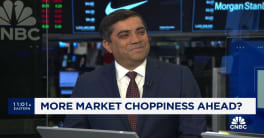If the first 2 hours of trading are any guide, markets will see their third day of gains this week following two weeks of declines. And stocks aren’t just up ― they’re soaring.
Just before noon, the Nasdaq is up 2.66% to 1847, its highest reading since July 1. The Dow has climbed 2.11% to 8536, and the S&P 500 is trading 2.08% higher at 925. The gains were led by the tech sector after the computer chip-maker Intel posted a smaller than anticipated decline in Q2 profits.
Intel’s CEO, Paul Otellini, said the the PC market was improving and they were expecting growth in the second half of the year.
"While the global economic environment is still recovering, our customers signaled increased confidence for a seasonal second half with their ordering patterns," he said in a call with analysts. "From a consumption perspective, consumer purchases led the way."
As of 10:30, shares of Intel were up 6.13%.
Data from the morning certainly didn’t hurt.
At 7am, the Mortgage Bankers Association reported that average mortgage rates fell to 5.05% last week, which helped loan applications move up 4.3%, including a 17% surge in refinancing.
“We will see more refis as rates come down,” said Robert Dye, senior economist at PNC Financial Group, prior to the release. “It’s nice to see mortgage rates coming down; that’ll be a linchpin for the recovery.”
At 8:30, the Consumer Price Index showed prices rising 0.7%, mostly due to a temporary rise in energy prices. Though the monthly gain far outpaces the 0.1% advance in the prior month, it was benign compared to the 1.8% gain in producer prices, suggesting that producers are squeezing profits rather than passing on costs.
“In general, today's report on consumer prices suggests very little, if any pressure on consumer prices other than the temporary surge in gasoline prices,” said chief financial economist Brian Bethune from IHS Global Insight.
Core CPI, which excludes volatile energy and food prices, rose 0.2% in the month after a 0.1% advance in May. The rises were broad based, with prices of new and used vehicles, recreation, and apparel all advancing at least 0.5%.
Deutsche Bank’s Joseph LaVorgna commented, “Over the last 12 months, the core CPI has risen 1.7%, but we expect it to eventually fall below 1% over the next year and a half in lagged response to the recession.”
Also at 8:30, the New York Fed’s Empire State survey showed regional manufacturing conditions were stabilizing with a score of -0.6, the best reading since April 2008.
“The details of the survey suggested a more modest improvement than the headline index,” said analysts from RDQ, noting that the employment component continued to show significant downward pressure with a -20.1 reading.
At 9:15, the Federal Reserve’s nationwide Industrial Production report said output didn’t decline as much as analysts had predicted in June. IP fell for the eighth straight month, but the 0.4% dip in June was smaller than expectations for a 0.7% decline
Noting that manufacturing dropped more precipitously in the first three months of the year, RDQ said “the rate of growth of productivity in manufacturing looks to have picked up sharply in the second quarter.” They added that declines in business spending on capital equipment looks to have eased at the end of Q2 as well.
Overall, production in the second quarter fell by an annual rate of 11.6%, which is far from good, but it compares favorably to to the annual drop of 19.1% in Q1.
Jennifer Lee from BMO Capital Markets noted that Q2’s drop marks the 5th straight quarterly decline. “The longest stretch of quarterly drops is 6, a feat made in 2001, 1945 and 1930,” she added.
Later today at 2pm the Fed will release minutes from the FOMC meeting three weeks ago. The statement from the meeting pretty much stuck with the status quo, but analysts will be looking today for any comments related to an exit strategy, which the Fed has so far said little about.
If the minutes disappoint, expect chairman Ben Bernanke to address the concerns next Tuesday when he delivers the semi-annual report on monetary policy to the House Committee on Financial Services.







